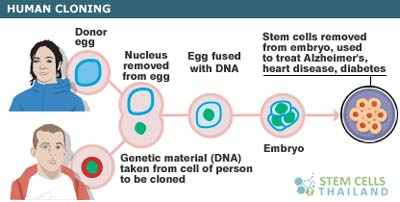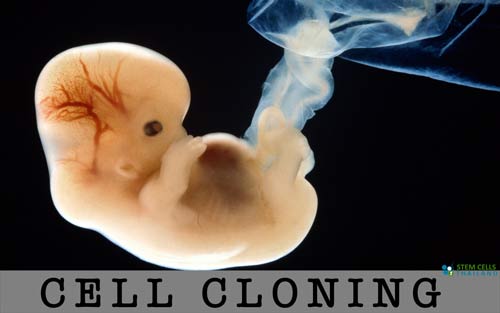Cloning is the process of generating replicas of a particular cell or organism, or even a portion of DNA.
What is Cloning?
Cloning a stemcell means to doctors are able to produce a population of cells from just one single cell.[1] The Cloning process produces unspecialized stem cells that are induced or differentiated to grow into various types of adult stem cells. These advances made through cloning embryonic stem cellshave led to revolutionary new regenerative therapies and also to prevent mitochondrial diseases from being passed from mother to child.[2] The development of cloning technology in Thailand has led to new methods of medicine delivery and is improving our understanding of human development and genetics.[3]

There is a lot of ethical debate over whether or not therapeutic cloning should be used. Cloning process is reproduced in vitro through asexually Cloning. This process refers to creating copies of DNA fragments and is also called molecular cloning ), cells (cell cloning), or organisms. Cloning involves producing genetically identical individuals. In the context of humans, cloning is a controversial and ethically charged topic. Two main types of cloning techniques have been discussed in scientific and bioethical contexts: reproductive cloning and therapeutic cloning.
Reproductive Cloning
Reproductive cloning aims to produce a genetically identical individual, or a “copy,” using a process known as somatic cell nuclear transfer (SCNT). In SCNT, the nucleus of an egg cell (oocyte) is replaced with the nucleus from a somatic cell (any cell other than a sperm or egg), and the egg is then stimulated to divide and develop into an embryo. The embryo can be implanted in a surrogate to develop into a full organism.
Controversies and Concerns with Reproductive Cloning
- Ethical Issues: The idea of creating a genetically identical human raises profound ethical questions about individuality, identity, and the nature of parenthood.
- Safety Issues: Reproductive cloning in animals has resulted in a high number of failures, with many clones suffering from abnormalities or dying prematurely. Translating this to humans could result in miscarriages, premature aging, and severe congenital disabilities.
- Legal Status: Many countries including Thailand have banned reproductive cloning in humans due to these ethical and safety concerns.
Therapeutic Cloning
Therapeutic cloning, also known as somatic cell nuclear transfer (SCNT) for the purpose of generating embryonic stem cells, involves the same initial steps as reproductive cloning. However, instead of implanting the embryo to produce a new individual, the embryo is cultivated in vitro to generate stem cells. These stem cells can potentially be used to develop tissues or organs for transplantation.
Potential Benefits of Therapeutic cloning
- Regenerative Medicine: The stem cells produced could be genetically identical to the donor, reducing the risk of transplant rejection.
- Disease Modeling and Drug Testing: It could provide a way to create patient-specific cell lines to study diseases or test potential treatments.
Controversies, Concerns & Ethical Issues: The process involves creating and then destroying an embryo, which raises moral concerns, particularly among those who believe that the moral status of an embryo is equivalent to a human being. - Alternatives to cloning: Induced pluripotent stem cells (iPSCs) provide an alternative to therapeutic cloning for generating patient-specific stem cells without creating embryos. The discovery of iPSCs has somewhat reduced the emphasis on therapeutic cloning in stem cell research.
Technical Challenges of Cloning
Both forms of cloning face technical challenges, including low efficiency and the potential for abnormalities in the cloned cells or tissues. While cloning technologies have the potential to revolutionize medicine, they also raise profound ethical, moral, and safety concerns. As with all groundbreaking technologies, there is a need for robust public discussion, rigorous scientific evaluation, and careful regulatory oversight.
Organism cloning or “reproductive cloning” refers to the process of creating a new multicellular organism that is 100% genetically identical to each other. There are also many potential dangers in cloning human cells. Many scientists believe that human cloning is only about 10 or 15 years away still because the process is far more difficult than cloning a sheep. Human reproductive cloning is Banned in most countries and also not allowed in Thailand.[4]
Published Clinical Citations
[1] ^Imsoonthornruksa, Sumeth, Chanchao Lorthongpanich, Anawat Sangmalee, Kanokwan Srirattana, Chuti Laowtammathron, Wanchai Tunwattana, Wachiravit Somsa, Mariena Ketudat-Cairns, Takashi Nagai, and Rangsun Parnpai. 2011. The effects of manipulation medium, culture system and recipient cytoplast on in vitro development of intraspecies and intergeneric felid embryos. The Journal of reproduction and development, no. 3 (February 14). https://www.ncbi.nlm.nih.gov/pubmed/21325740
[2] ^ Imsoonthornruksa, Sumeth, Kanokwan Srirattana, Wanwisa Phewsoi, Wanchai Tunwattana, Rangsun Parnpai, and Mariena Ketudat-Cairns. 2012. Segregation of donor cell mitochondrial DNA in gaur-bovine interspecies somatic cell nuclear transfer embryos, fetuses and an offspring. Mitochondrion, no. 5 (July 21). doi:10.1016/j.mito.2012.07.108. https://www.ncbi.nlm.nih.gov/pubmed/22824460
[3] ^ Liu, J, Y Wang, J Su, Y Luo, F Quan, and Y Zhang. 2013. Nuclear donor cell lines considerably influence cloning efficiency and the incidence of large offspring syndrome in bovine somatic cell nuclear transfer. Reproduction in domestic animals = Zuchthygiene, no. 4 (January 16). doi:10.1111/rda.12140. https://www.ncbi.nlm.nih.gov/pubmed/23320388
[4] ^ Imsoonthornruksa, Sumeth, Anawat Sangmalee, Kanokwan Srirattana, Rangsun Parnpai, and Mariena Ketudat-Cairns. 2012. Development of intergeneric and intrageneric somatic cell nuclear transfer (SCNT) cat embryos and the determination of telomere length in cloned offspring. Cellular reprogramming, no. 1 (January 4). doi:10.1089/cell.2011.0054. https://www.ncbi.nlm.nih.gov/pubmed/22217197

